6 Electoral systems
Jill Sheppard
Key terms/names
compulsory voting, consensual systems, district magnitude, majoritarian systems, mixed member proportional systems, party list voting, plurality voting, preferential voting, proportionality, representation, single transferable vote, voluntary voting, voter turnout
Electoral systems are a centrally important aspect of any polity.[1] In the Australian context, the electoral system explains much of the country’s stability, centrist policies and conservative political culture. This chapter introduces electoral systems broadly, with particular focus on the Australian context. How we vote is shaped by three key features of the electoral system: what ballot papers look like; how ballot papers are counted and legislative seats allocated; and when, where, and why we vote.
Electoral systems need to balance many different, and often competing, goals. The system we use to choose members of a legislature – that is, to elect legislators – largely dictates how many parties we have to choose from, the kinds of people who stand for election, the kinds of people who get elected and the kinds of policies they produce once elected. There is no aspect of any political system that is not deeply influenced by the fundamental electoral system.
In Australia, we take much about our electoral system for granted. We vote on Saturdays, so most voters do not have to take any time off work. The lines to cast a vote are short, compared to other countries’ elections. Election days are – for the most part – enjoyable rituals. And if we do not want to vote on election day, we have ample opportunity to vote beforehand, either in person or by post. Both the prime minister and the opposition leader are often ideologically centrist; this is a fundamental feature of Australia’s electoral system. While we may change prime ministers, our underlying political system is stable and strong. And we have our electoral system to thank.
The sections in this chapter take the following format. First, the chapter will discuss compulsory and voluntary voting. Australians are socialised into accepting and even embracing compulsory voting; that phenomenon will be examined here. Second, the chapter will consider the major types of electoral systems, focusing on consensual and majoritarian systems. It will discuss the advantages and disadvantages of each, using contemporary examples.
Compulsory and voluntary voting
Eligible Australian voters are required by law to both enrol to vote and cast a ballot in all federal and state elections. In 1924, the parliament of Australia amended the Commonwealth Electoral Act 1918 (Cth) to make voting compulsory and allow the federal government to penalise enrolled voters who fail to cast a ballot. In 1924, the penalty for non-voting was £2 (or approximately $160 in 2018); in 2019, the penalty is $20.
Among other clauses, the 1924 amendments that introduced compulsory voting state that:
- It shall be the duty of every elector to vote at each election.
- The Electoral Commissioner must, after polling day at each election, prepare for each Division a list of the names and addresses of the electors who appear to have failed to vote at the election.
- … within the period of 3 months after the polling day at each election, each DRO [Divisional Returning Officer] must:
A. send a penalty notice by post; or
B. arrange for a penalty notice to be delivered by other means to the latest known address of each elector whose name appears on the list prepared under subsection (2).[2]
This legislative measure was passed to address declining voter turnout in general elections – fewer than 60 per cent of registered electors cast a ballot at the 1922 Australian federal election. At a recent federal election (in May 2019), turnout was 92 per cent of the registered voter population, with the highest number of enrolled voters on record.[3]
As it compels voting, the Australian government has consistently legislated to make it as easy as possible. This has included weekend (Saturday) election days, expansive access to voter registration (although limited to a deadline of one week prior to an election), ample polling locations and short queues at polling booths. Recent reforms have expanded voters’ opportunities to cast a ballot before election day, either by mail or in person. By convention as much as legislative or institutional design, the Australian Electoral Commission (AEC) has worked to lower the burdens of voting within the constraints of maintaining electoral integrity (which explains its the reluctance to introduce election-day registration opportunities, for instance).
Australian Election Study data since 1967 reveals remarkably high levels of support for compulsory voting within Australia. Early iterations of the study found that in 1967 and 1969 three-quarters of the population believed ‘compulsory voting is better’ than allowing people to vote if they want. By 1979, that number had fallen slightly, but 69 per cent of Australians still preferred compulsory to voluntary voting. In 1987, 33 per cent of Australians ‘strongly favoured’ compulsory voting, 31 per cent ‘favoured’ it, 3 per cent did not mind either way, 13 per cent favoured voluntary voting and 20 per cent ‘strongly favoured’ voluntary voting. Since that time, support for Australia’s compulsory voting laws has remained remarkably high (Figure 1).
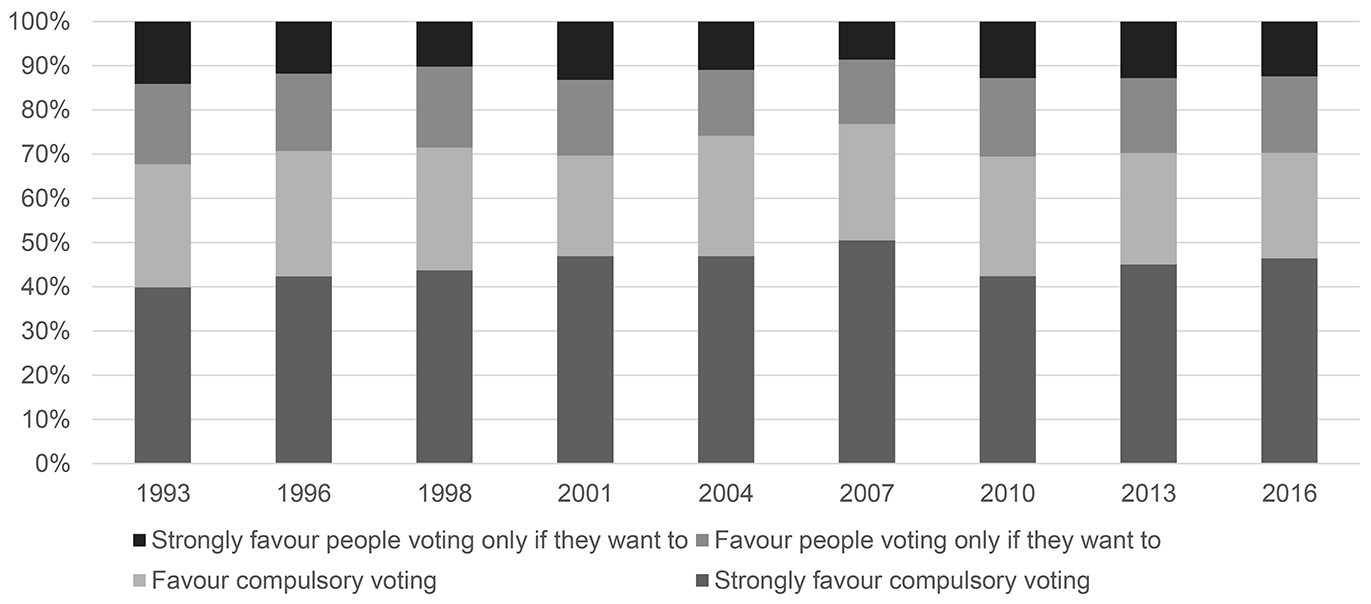
How ‘compulsory’ is compulsory voting?
While the vast majority of eligible voters in Australia fulfil their legal obligation to vote at each election, there are two means of easily abstaining from casting a valid vote. The first method is to attend a polling booth, either on or before election day (or to request a postal ballot paper), receive a ballot paper and deposit that paper in the ballot box (or return it via post) without writing a valid vote on it. Many Australians do this intentionally, either leaving their ballot blank or marking the paper in ways that do not constitute a valid vote. Others cast a spoiled ballot unintentionally; Australia’s comparatively complex ballot paper makes voting formally particularly difficult for voters with poor literacy or English-language proficiency.
The extent to which the Commonwealth Electoral Act 1918 commands voters to (or to attempt to) cast a valid ballot is not entirely clear. Some commentators and political actors believe that voters only need to attend a polling booth (or request a postal ballot paper) and have their name marked off by an AEC employee; we will call this the ‘attendance only’ argument. Others argue that the law requires voters to place a ballot paper into a ballot box (or return a postal ballot paper to the AEC), whether it contains a valid vote or not – the ‘blank ballot’ argument. Others still argue that the legislation requires voters to intend to cast a valid vote (the ‘valid vote’ argument) – that the ‘duty of every elector to vote’ extends to expressing their preference for certain candidates over others.
The ‘attendance only’ argument is driven by the reality that, per the Act, the Electoral Administrator collects the names of enrolled voters who have not attended a polling station and had their attendance noted by AEC staff. These individuals are then subject to penalties for non-voting. The AEC has no means of penalising Australians who have their names marked off, walk to the polling booth and destroy their ballot paper without depositing it into the ballot box.[4] However, five separate instances of judicial review have found that the Commonwealth Electoral Act 1918 requires voters to deposit a ballot paper into the box.[5]
The legality of submitting a blank ballot paper to fulfil the duty to vote in Australia federal elections is less clear. A strict reading of the Act suggests that ‘to vote’ requires a voter to mark their ballot paper in such a way as to reflect a preference for some candidates over others.[6] Again, however, the secrecy of the voting process means that voters who cast a blank (or otherwise informally marked) ballot paper are not able to be penalised. In practice, then, the ‘blank ballot’ argument stands; it is legal to submit a blank ballot paper in Australia, in as much as doing so cannot reasonably be punished under the relevant law. Moreover, casting a blank ballot is widely viewed as a legitimate form of political expression in Australia.[7] Lijphart notes that ‘the secret ballot guarantees the right not to vote remains intact’,[8] while Twomey argues that the secret ballot and compulsory voting as defined by the Act are essentially at odds.[9]
However, individuals suspected of casting a blank ballot paper could be required to confess to deliberately abstaining from voting and be penalised accordingly under the Act.[10] For instance, the Act requires the electoral commissioner to prepare a list of names of eligible voters who have not voted in a federal election; it is not far-fetched to imagine the AEC identifying individuals who confess on social media to deliberately casting a blank or otherwise informal ballot.
As of 2019, the AEC has shown little appetite for such proactive penalisation. Prior to the 2010 Australian federal election, former Labor leader Mark Latham publicly announced that he would be casting a blank ballot and urged others to do likewise.[11] The AEC told media outlets reporting on these comments that Latham did not contravene the Act, either by casting a blank ballot himself or by telling others that he would do so.
The second means of abstaining is to not enrol to vote. Electoral enrolment is compulsory under the Commonwealth Electoral Act 1918. The Act mandates that eligible voters must register themselves as voters with the AEC and maintain their enrolment by advising the AEC any time they change their residential address. Since 2012, the AEC has had legislative power to ‘directly update’ the electoral roll. This allows the AEC to identify eligible voters using data from other federal and state government agencies – vehicle registration and driver licencing authorities, welfare agencies and utility providers, for example – and automatically add them to the electoral roll. The AEC notifies all individuals who are automatically added to the roll, and these individuals have 28 days in which to object (although there are almost no grounds for valid objection, besides the individual’s details being incorrect).
These new powers have diminished Australians’ ability to ‘hide’ from the AEC – and from having to vote in elections – by never enrolling to vote. Eligible voters who are directly added to the roll are not fined for having abstained previously. In 2018, 96 per cent of eligible Australians were enrolled to vote. In 2011, before the direct update legislation was introduced, only 91 per cent of eligible Australians were enrolled. Among eligible young Australians (those aged 18 to 25), enrolment has increased from 73 per cent in 2011 to 85 per cent in 2018. Direct updating reversed a trend of declining voter enrolments generally, but particularly among young Australians. At the beginning of 2019, approximately two-thirds of all electoral enrolment in Australia occurs via direct update of the roll.
Majoritarian and consensual electoral systems
There are many common ways of categorising and describing electoral systems, but most approaches identify three broad types based on the type of government they produce. Drawing on Norris and Lijphart,[12] we can distinguish between three electoral ‘families’: majoritarian, mixed and consensual. This section will begin by defining and describing majoritarian democracies and the types of electoral systems that produce ‘winner takes all’ governments. Next, it will discuss consensual democracies and the electoral systems that produce governments where two or more parties share power in coalition. Finally, it will discuss democracies that fall somewhere between majoritarian and consensual.
Majoritarian (or ‘winner takes all’) systems
In Australian federal elections, we vote for candidates standing for two different houses: the House of Representatives (lower house) and the Senate (upper house). Whichever party or group of parties wins a majority of seats in the House of Representatives is, according to the Constitution of Australia and convention since 1901, given the opportunity to form a government. Much more often than not, one party (or in the case of the Liberal–National Coalition [the Coalition], a formal alliance of parties) gets to form a government in its own right. Why? And relatedly, why do the Coalition and Australian Labor Party (ALP) have such a stranglehold on government in Australia?
The answers lie in Australia’s system of electing one person to represent each electoral division in the country. In electoral terms, Australia’s House of Representatives has a ‘district magnitude’ of one (i.e. one member per electoral division). For example, in the seat of Fenner in the Australian Capital Territory (ACT), the candidate who wins the majority of the vote is elected. A second-placed candidate – even if they attract 49.99 per cent of the final vote – wins nothing.
There are two specific electoral systems that produce majoritarian governments. The first is plurality, or ‘first past the post’, voting. This is the most straightforward way of voting, both in terms of the voter recording their preferred candidate and for electoral commission staff counting votes at the end of election day. Used in the UK and in most USA elections, plurality voting requires voters to choose their favourite among all listed candidates. They do not need to rank candidates; depending on the jurisdiction they can use a cross, a number ‘1’ or a tick to designate their chosen candidate. The simplicity of plurality voting helps to include non-native-language speakers and those with low literacy in the electoral process.
On the other hand, plurality voting results in the most disproportionate electoral outcomes of any voting system. Imagine an electorate in London in which 50.001 per cent of voters choose one candidate, Jane Smith. In the unlikely event that all of Jane Smith’s votes were counted first, there would be no need to ever count the other 49.999 per cent of votes. In an electorate of 100,000 voters, 49,999 votes would not even need to be counted; we could declare the winner based on the total votes for Jane Smith. Therefore, 49,999 voters would have left their homes, lined up and filled in and cast a ballot, just for it not to have mattered. Such votes are called ‘wasted votes’ in the political science literature; we regularly assess electoral systems on the basis of the percentage of wasted votes.
The Australian House of Representatives uses preferential voting, a less common majoritarian electoral system.[13] In a preferential system, voters mark their preferred candidate but also get to rank the other candidates. Voters’ ability to rank candidates in order can be seen as offering an alternative: if my favourite candidate (John Scott) is not popular, then I want my vote to go to my next preferred candidate (Jessica Shaw), and so on.
When voting closes at the end of election day, electoral staff count up all of the ‘1’ (i.e. first preference) votes. You might imagine a pile of ballot papers for each candidate, based on how many voters gave the candidate their number ‘1’ vote. Once this count is finalised, the candidate who received the fewest ‘1’ votes is eliminated, and their votes redistributed to whichever candidates received the number ‘2’ votes on these ballot paper. This continues until there are only two candidates left; you might have heard of ‘two-party preferred’ or ‘two-candidate preferred’ results – this is exactly that. After unpopular candidates are eliminated and voters’ preferences distributed, the final two candidates are the ‘two candidates preferred’.
Preferential voting has one distinct advantage over plurality voting, and one distinct disadvantage. The advantage is that very few votes are wasted; even if a voter casts a vote for the least popular candidate in any election, their vote will transfer to their next favourite candidate, and their next favourite candidate, and so on. Inevitably, this means that any election comes down to the two candidates whom voters are least likely to rank last, rather than the candidates they are most likely to rank first. However, this is quite a complicated electoral system (requiring voters to place a sequential number next to every candidate or else invalidate their ballot), which disadvantages voters from non-English-speaking backgrounds and those with low literacy. This trade-off is an ongoing challenge for electoral administrators.
In majoritarian systems – whether plurality or preferential – candidates (or parties) who are ideologically similar usually try to avoid ‘stealing’ votes away from each other. Imagine, for instance, two socialist-leaning parties nominating candidates in an American congressional district. If they do not co-ordinate, they might each win 26 per cent of the vote, leaving a conservative candidate to win with 48 per cent of the vote. For both socialist-leaning candidates, this is the least optimal outcome – they lose, and a conservative (i.e. the most ideologically distant) candidate wins.
Instead, it makes sense for ideologically similar candidates or parties to work together. While it might be difficult to imagine political rivals working together – even if they hold very similar ideas or espouse similar policies – we assume that over the long term candidates and parties with similar outlooks will work together to exclude common rivals. ‘Working together’ might mean that one candidate or party withdraws from an election or decides not to nominate in the first place; it does not necessarily mean that they openly collaborate or campaign together.
This phenomenon is called ‘Duverger’s Law’, named for political scientist Maurice Duverger (pronounced Doo-ver-zhay).[14] It is as close to a ‘universal law’ as anything in political science, although it still has exceptions; for example, Canada consistently has three major parties despite its plurality voting system. But commonly, Duverger’s Law correctly predicts that majoritarian voting methods lead to stable two-party systems. The UK, USA and Australia are the most notable examples. When the loosely formed ‘Tea Party’ collective of conservative politicians gained prominence in the USA in 2009, the group’s greatest success was (albeit briefly) pulling the Republican party to the right, rather than becoming a genuine third force in American politics. Even a group of activists ostensibly opposed to the policies of the most ideologically similar party is better served by working within that party than competing against it.
The combination of compulsory and preferential voting has maintained a very stable two-party system in Australia. The two major parties – the ALP and the Coalition – have both enjoyed substantial periods in executive government and are ideologically proximate. At federal elections between 1949 and 2016, only twice has either major party defeated the other by ten percentage points or more (Figure 2). Even though many Australians might express dissatisfaction with the closeness of the parties and the way the political system works generally (and in 2019 political dissatisfaction is increasing in Australia), we overwhelmingly still turn up to vote, and we still mostly vote for one of the major parties.
Compulsory voting means voters at the far left and far right of the ideological spectrum are still incentivised to vote, even though the parties they end up voting for (after preferences are distributed) are a long distance from their own positions. This is one reason that the Australian Greens and – to a lesser extent – right-wing parties like One Nation have emerged in Australia, despite Duverger’s Law. For many voters on the left, the Greens are a far more palatable electoral option than the ALP, who – along with the Liberal Party – have converged on the centre of the left–right spectrum.
The electoral outcomes of majoritarian systems highlight both their major strength (political stability) and their major weakness (lack of ideological representation). The other major family of electoral systems – consensual systems – have the opposite problem: their key strength is in representing views across the ideological spectrum, but they often suffer from political instability.
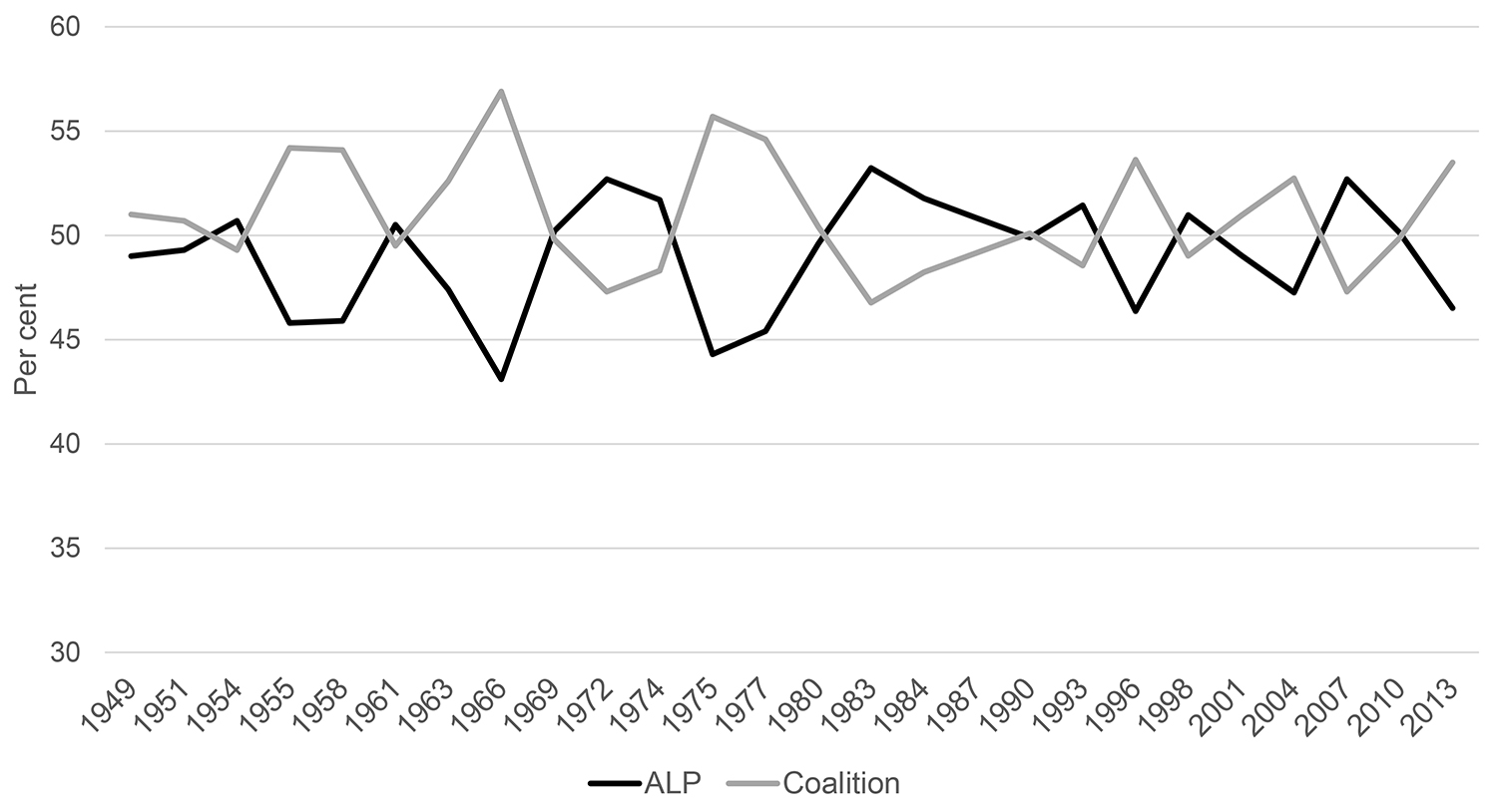
Consensual systems
In almost all of South America, and northern, central and western Europe, voters elect more than one candidate to represent their electoral division. Instead of one local member, they might have two, three or more. The number of representatives in each district is called district magnitude, and while it may seem a small thing, it has a large effect on electoral outcomes, the number of parties that contest elections and win seats, the stability of governments and the kinds of policies that the legislature and government produce.
According to Duverger’s Law, parties with similar ideological positions will inevitably either merge or withdraw from elections to avoid stealing votes from each other and allowing ideologically distant parties to win. In multi-member districts (i.e. where the district magnitude is two or higher), ideologically similar parties or candidates can both nominate for election and plausibly be elected. They may still ‘steal’ votes from each other, increasing the total vote share of a common political opponent, but as the vote share required for winning is lower the chance of either or both candidates winning at least one seat is higher.
Imagine a local election in which five members are being chosen to represent one division. There are 20 candidates nominated: five centre-left candidates, five centre-right candidates, five candidates from the far left and five candidates from the far right. In a plurality (‘first past the post’) election, the far left and far right candidates might withdraw to shore-up electoral support for the centre-left and centre-right candidates respectively. With five seats up for grabs, however, the more extreme candidates are more likely to stay in the contest.
In elections for the ACT Legislative Assembly, voters elect five representatives in each of the five divisions. The legislature is comprised of 25 representatives, with any party that can control a majority of members given the right to form a government. In the 2016 election, two divisions elected three ALP members and two Liberal members. One division elected three Liberal members and two ALP members. The other two divisions each elected two ALP members, two Liberal members, and one Greens member.
The final distribution of seats was 12 to the ALP, 11 to the Liberals and two to the Greens. Accordingly, neither major party was able to form a government in its own right, as neither had a clear majority of seats in the Assembly. Three plausible outcomes might have followed. First – and least likely, based on historical trends – the two major parties could have formed a coalition to govern together, with a 23 to two seat majority over the opposition Greens party. Second, the two Greens members could have joined the 11 Liberals to form a 13 to 12 seat majority over the opposition ALP.
Finally, and most likely given their ideological positions, the two Greens members could join the 12 ALP members to form a 14 to 11 majority over the opposition Liberals. This is precisely what happened, with the Greens and ALP leaders signing a formal pact to ensure the stability of the coalition government. The Greens promised to only support any motion of no confidence against the ALP-led government in the case of misconduct or corruption, and the Greens’ leader was rewarded with a ministerial appointment. Similar ALP–Greens coalitions have governed in Tasmania, which uses an identical electoral system to the ACT.
This kind of electoral outcome, in which no one party wins a clear majority of seats, and government formation, in which two or more parties must work together to form a majority coalition, is common throughout much of the democratic world. Further, it often occurs on a much larger scale. In the 2017 German federal election, no party won a majority of seats in its own right. Incumbent Chancellor Angela Merkel’s centre-right Christlich Demokratische Union Deutschlands/Christlich-Soziale Union in Bayern (CDU/CSU) party won the most seats (246 of 709), while the left-wing Sozialdemokratische Partei Deutschlands (SPD) won the second most (153 of 709). The third most successful party, with 94 seats, was the far right Alternative für Deutschland (AfD).
Initially, the CDU/CSU attempted to negotiate a coalition agreement with two much smaller parties, the semi-libertarian Freie Demokratische Partei (FDP) and the left-wing (but environmentally focused) Bündnis 90/Die Grünen (Greens). Negotiations failed when the three parties could not agree on immigration and energy policy positions. Eventually, the CDU/CSU and SPD formed a ‘grand coalition’ (the term used to describe the two largest parties governing together), with 504 of the Bundestag’s 709 seats. This was the third time in the Merkel government’s four terms that the two parties had governed together. The parties share little common ideological ground, with each compromising considerably on a range of policies in order to produce a workable coalition agreement.
While the ensuing ‘grand coalition’ represents a large portion of the German left–right political spectrum, we also expect it to be relatively unstable. Either or both parties might choose to dismantle the coalition (likely causing new elections to be held), rather than continue to compromise on so many issues and support policies that are a long ideological distance from their usual position. Where parties are closer in terms of their ideological and policy preferences, they both (or all, in the case of larger coalitions) have greater interest in maintaining the coalition and staying in government.[15] We also know from the German case that individuals who had voted for candidates from ‘grand coalition’ member parties are less likely to vote for those parties in subsequent elections.[16] In other words, they punish parties for entering and governing in coalitions with other large, ideologically dissimilar parties.
In this way, consensual political systems face the opposite dilemma to majoritarian systems. They provide high levels of representation by opening up government and ministerial appointments to more than one party (and often to parties representing a large range of ideological views). On the other hand, parties can withdraw from a coalition agreement at any time, causing the government to collapse and new elections to be held. Accordingly, consensual systems can see more voters changing their mind between elections, and higher rates of government turnover and of parties emerging and dying.
While specific forms of majoritarian electoral systems are rather straightforward and few in number, there are many ways of electing consensual governments, with a large range of complexity. The most common electoral system producing consensual outcomes is called party list voting. In party list systems, parties are allocated a percentage of seats based on the percentage of votes they receive. The closer the percentage of votes won to the percentage of seats won, the more proportional a system is. Depending on whether an electoral threshold is used in a party list system, parties might be required to win a certain percentage of votes before they are awarded a seat. Further, the means by which ‘remainders’ are distributed (e.g. if a party wins 38 per cent of votes in a ten-seat division, they will only be allocated three seats and 8 per cent of the total votes are ‘remainders’) will contribute to system proportionality. However, these are secondary concerns.
Imagine an electoral division with ten seats vacant. Each party nominates a list of candidates for election, with a maximum of ten candidates (because, in the unlikely event that the party wins 100 per cent of the vote, there are only enough seats for ten candidates). The most successful party, the fictional Centrist Conservatives, wins 30 per cent of the vote and is awarded three seats. In a closed party list system, parties determine the order of candidates on the list, meaning that the Centrist Conservative’s three most preferred candidates are automatically elected. In closed list systems, parties and their members have a lot of control over the selection of candidates, and we expect that candidates will react by focusing on party members at the expense of their constituents (although little evidence exists to support this hypothesis).
In an open party list system, voters can vote for whichever candidate they like within a list. Often, open lists are randomised so that parties cannot indicate any preference for individual candidates. Each vote – despite ostensibly being cast for an individual candidate – is counted as a vote for the party first and the candidate second. If the Centrist Conservatives win 30 per cent of the vote, they still win three seats but the elected candidates are determined by the highest individual vote share. The result is an outcome that prioritises parties over candidates, but does not give parties total control over who is elected. Further, it makes elected representatives accountable to voters, rather than just their parties; a candidate who is a favourite of party officials will not be elected if voters do not know them or do not approve of them.
Beyond party-list systems, the other common means of electing consensual governments is single transferable vote (STV). STV is used to elect the Australian Senate, and variants of it are used to elect the ACT and Tasmanian governments. The key feature of STV is that voters can rank individual candidates. Once a candidate reaches a predetermined quota, any additional votes are transferred to the candidates ranked second on each ballot paper. In the Australian Senate, the quota is calculated by:
The number of formal ballot papers cast
(The number of senators to be elected + one) rounded down + one
Votes additional to this quota are transferred at a reduced value, calculated as:
Additional votes
Number of votes for candidate
As with preferential voting in majoritarian systems, the least popular candidate is eliminated at the end of each round of counting. This candidate’s votes are transferred to the next ranked candidates at the full value of the original vote (i.e. one vote = one vote). The form of STV used in the Senate is particularly party-centric: candidates are grouped by the party that they are representing and listed in the order predetermined by that party. Voters have the option of either ranking individual candidates in the order they choose (see Figure 3) or (the much less time-consuming option) ranking the parties as groups of candidates and automatically allocating their preferences per the parties’ predetermined candidate ranking (Figure 4). Independent candidates can nominate for the Senate, and often choose to be grouped with other independents in an ‘unaligned’ or similar group in order to maximise their collective vote share. The unnamed group in Figure 4 is an example.
Hare–Clark systems, such as those used in Tasmania and the ACT, do not give voters the option of ranking parties. Rather, candidates are grouped by party (or independent status) on the ballot paper, but voters must rank them individually (see Figure 5). Moreover, both Tasmania and the ACT use ‘Robson rotation’: the electoral commission prints as many versions of the ballot paper as there are candidates in the largest group, with the order randomised and each candidate appearing at the top of the list as often as every other candidate in their group. Accordingly, the parties have no power to promote particular candidates via the ballot paper; as in open party-list systems, candidates need to be known to and trusted by voters themselves.
Mixed systems
Some jurisdictions have successfully combined elements of majoritarian and consensual electoral systems. Although German elections have consistently produced coalition governments, the country actually has a semi-consensual electoral system. Voters get to cast two ballots: one for their local electoral division (i.e. a ‘local member’) and one vote for a party. They can vote for a local candidate representing one party, but cast a party vote for an entirely different party. In this way, parties are incentivised to provide both strong local representation and a clear, cohesive vision for the country. New Zealand has a similar system, allowing voters both an electorate and party vote (see Figure 6). Representatives elected from the electorate and party lists – with the latter appointed in a closed party list process – sit together in the unicameral (i.e. one house) legislature. This combination of systems is commonly called ‘mixed member proportional’, and many political scientists laud its combination of representation and stability.[17]
Conclusions
This chapter has explored how electoral systems can affect political stability, responsiveness, representativeness and citizen satisfaction. It has also examined compulsory voting, an aspect of Australia’s electoral system that is often taken for granted, but one that is integral to the country’s political culture, party system and electoral outcomes. The combination of Australia’s majoritarian electoral system (in the federal House of Representatives, where government is formed) and compulsory voting has led to high levels of political stability and the long-term dominance of the major parties.
Although compulsory voting is comparatively rare and imposes a small but important burden on all eligible voters, Australians overwhelmingly support it. This chapter has described strong public support for Australia’s compulsory voting laws, the resulting high rates of voter turnout and the ease with which Australians are able to cast a vote. Finally, the chapter has given an overview of the two largest families of electoral systems – majoritarian and consensual – as well as those systems that combine elements of both. While majoritarian systems, such as plurality and preferential voting, provide political stability, they offer no representation for losing candidates and relatively little for opposition parties.
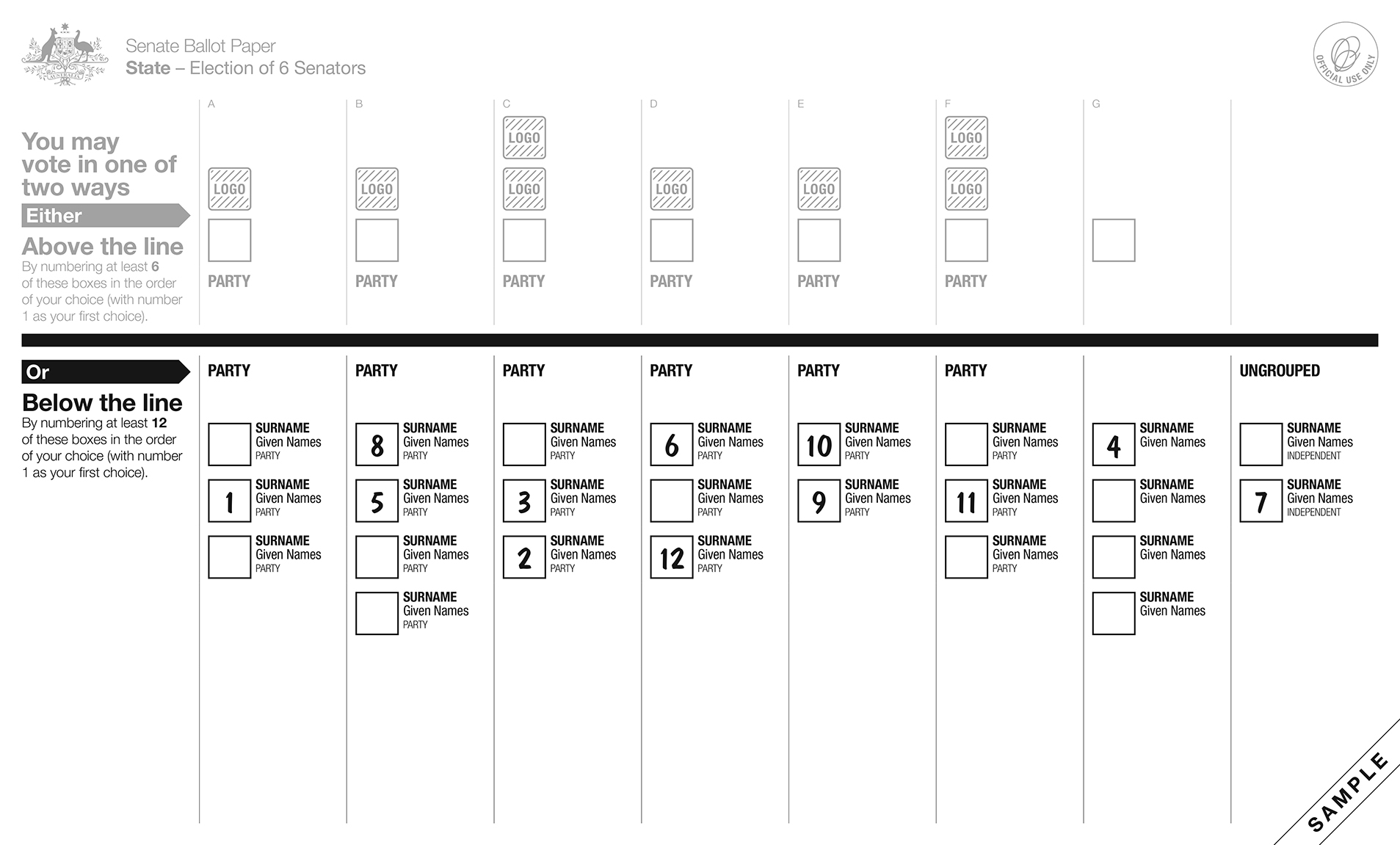
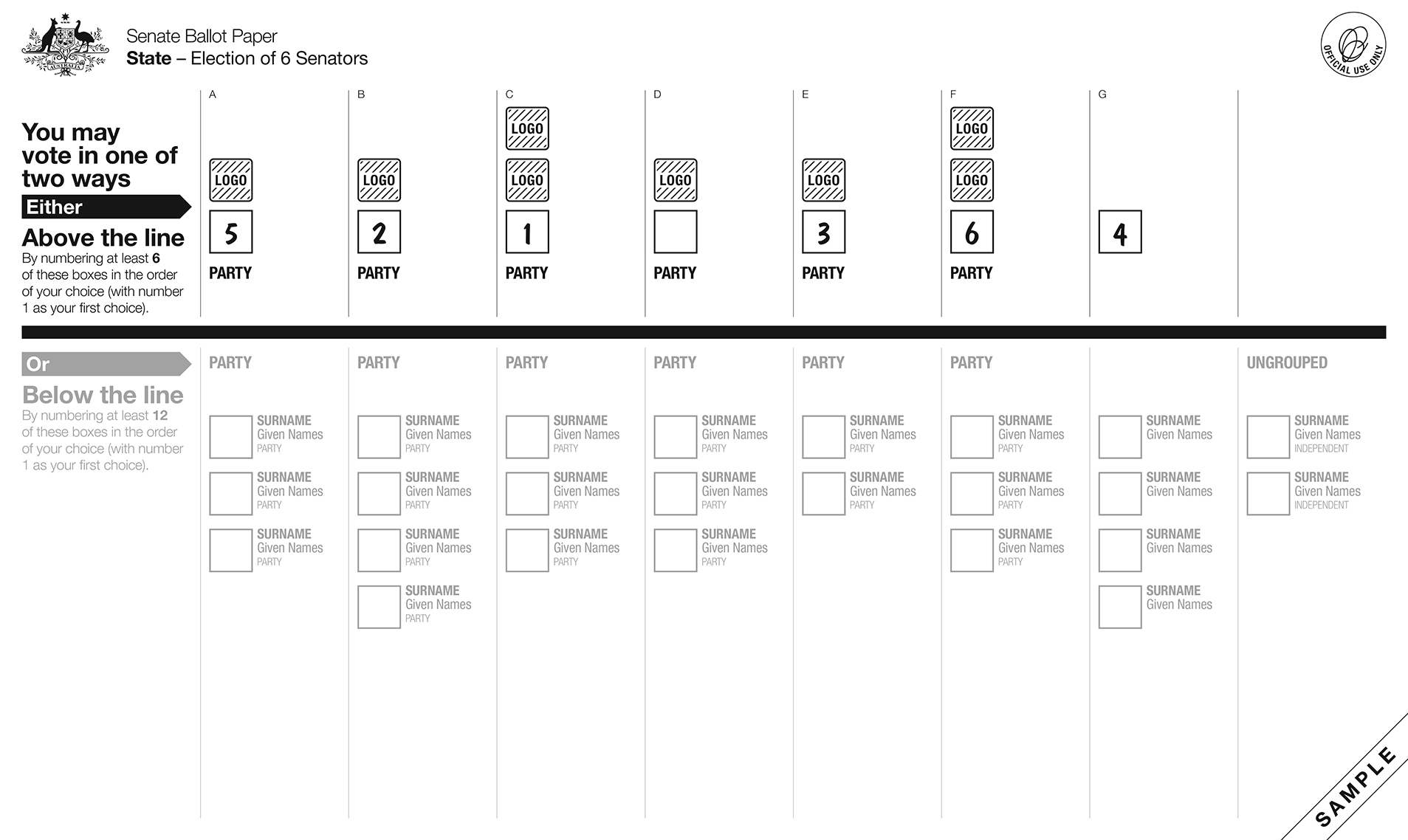
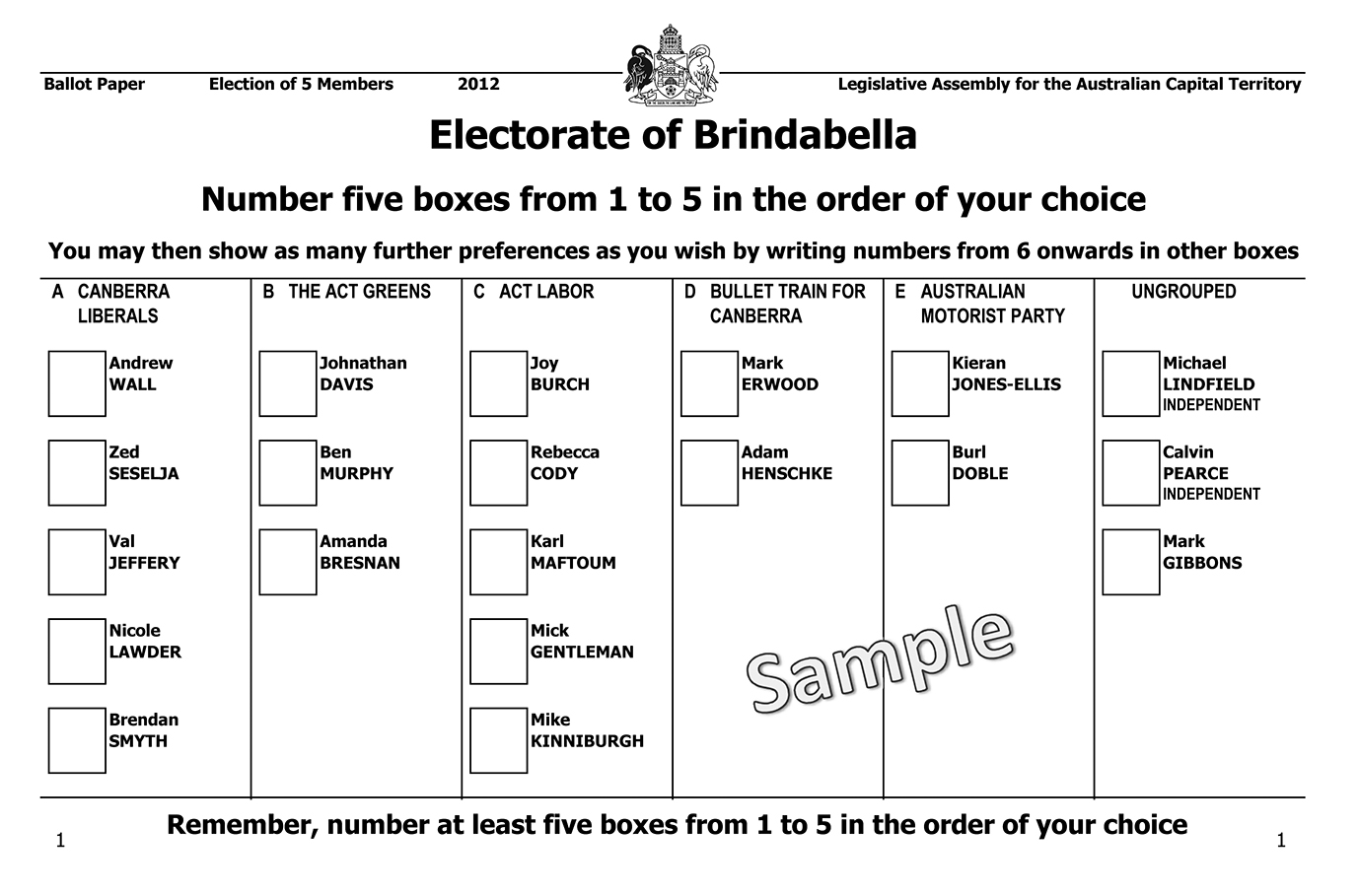
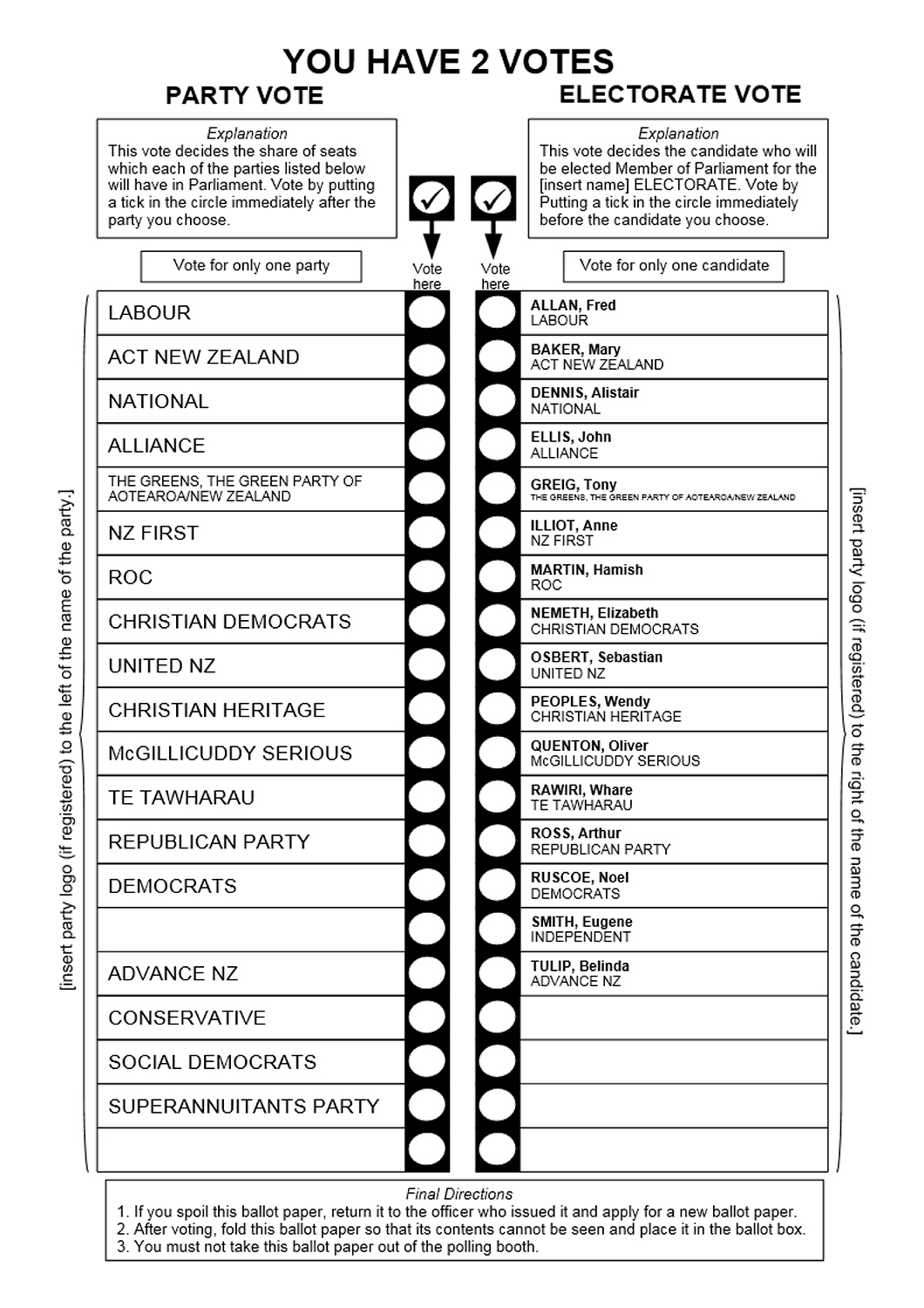
References
Australian Electoral Commission (AEC) (2019a). 2019 federal election downloads and statistics. https://www.aec.gov.au/elections/federal_elections/2019/downloads.htm
—— (2019b). Electoral backgrounder: compulsory voting. http://aec.gov.au/About_AEC/Publications/backgrounders/compulsory-voting.htm
—— (2016). House of Representatives – two party preferred results, 1949 to 2016. https://www.aec.gov.au/Elections/Australian_Electoral_History/House_of_Representative_1949_Present.htm
Banaszak, L.A., and P. Doerschler (2012). Coalition type and voter support for parties: grand coalitions in German elections. Electoral Studies 31(1): 46–59. DOI: 10.1016/j.electstud.2011.06.008
Cameron, S.M., and I. McAllister (2016). Trends in Australian political opinion: results from the Australian Election Study, 1987–2016. Canberra: Australian National University.
Hill, L. (2002). On the reasonableness of compelling citizens to ‘vote’: the Australian case. Political Studies 50(1): 80–101. DOI: 10.1111/1467-9248.00360
Lijphart, A. (1997). Unequal participation: democracy’s unresolved dilemma. The American Political Science Review 91(1): 1–14. DOI: 10.2307/2952255
—— (1994). Electoral systems and party systems: a study of twenty-seven democracies, 1945–1990. New York: Oxford University Press. http://www.oxfordscholarship.com/view/10.1093/acprof:oso/9780198273479.001.0001/acprof-9780198273479
Norris, P. (2004). Electoral engineering: voting rules and political behavior. Cambridge, UK: Cambridge University Press.
Powell, G.B., and G.B. Powell Jr (2000). Elections as instruments of democracy: majoritarian and proportional visions. New Haven, CT: Yale University Press.
Pringle, H. (2012). Compulsory voting in Australia: what is ‘compulsory’? Australian Journal of Political Science 47(3): 427–40. DOI: 10.1080/10361146.2012.704001
Riker, W.H. (1982). The two-party system and Duverger’s Law: an essay on the history of political science. The American Political Science Review 76(4): 753–66. DOI: 10.2307/1962968
Shugart, M., and M.P. Wattenberg (2001). Mixed-member electoral systems: the best of both worlds? Oxford: Oxford University Press.
Twomey, A. (1996). Free to choose or compelled to lie? The rights of voters after Langer v The Commonwealth. Federal Law Review 24(1): 201–20. DOI: 10.1177/0067205X9602400107
About the author
Dr Jill Sheppard is a lecturer in the School of Politics and International Relations at the Australian National University. Her research interests are elections and voting, political participation and public opinion, particularly in Australia but also internationally. She is an investigator on several major survey studies of Australian public opinion and behaviour.
- Sheppard, Jill (2024). Electoral systems. In Nicholas Barry, Alan Fenna, Zareh Ghazarian, Yvonne Haigh and Diana Perche, eds. Australian politics and policy: 2024. Sydney: Sydney University Press. DOI: 10.30722/sup.9781743329542. ↵
- Commonwealth Electoral Act 1918, section 245. ↵
- AEC 2019a. ↵
- See, for example, Twomey 1996. ↵
- AEC 2019b. ↵
- Twomey 1996. ↵
- Hill 2002. ↵
- Lijphart 1997. ↵
- Twomey 1996. ↵
- Twomey 1996, 210. ↵
- Pringle 2012. ↵
- Lijphart 1994; Norris 2004. ↵
- ‘Preferential voting’ is the commonly used term, while academics and researchers tend to describe this system as ‘alternative voting’, ‘ranked choice voting’ or ‘instant run-off voting’. These terms all describe the same system. ↵
- See Riker 1982 for a comprehensive discussion. ↵
- Powell and Powell Jr 2000. ↵
- Banaszak and Doerschler 2012. ↵
- Shugart and Wattenberg 2001. ↵

